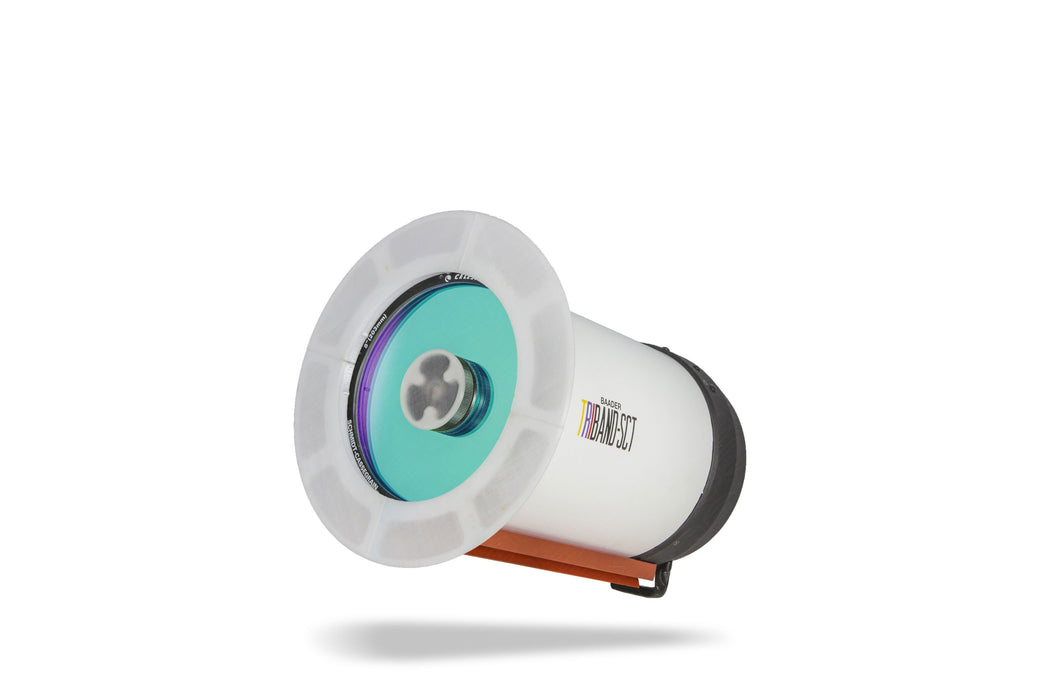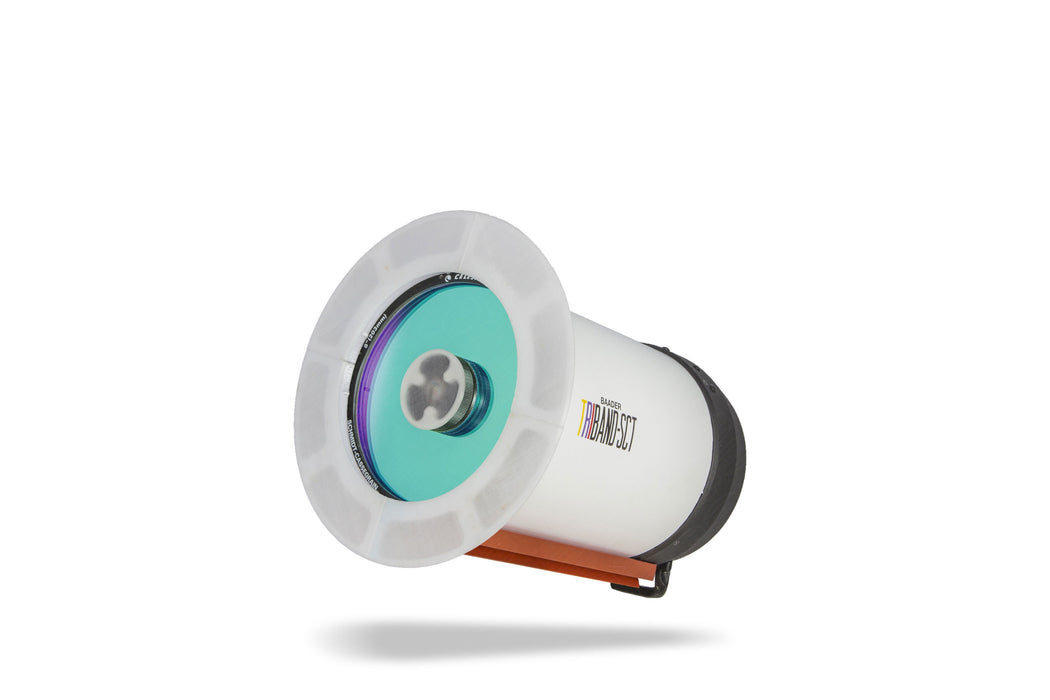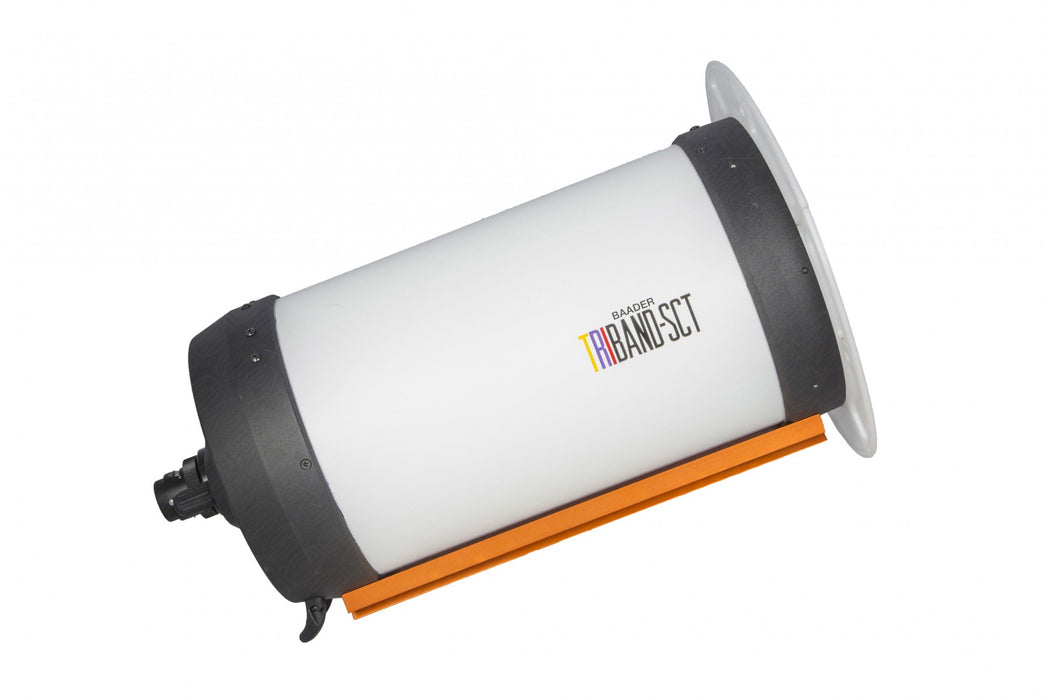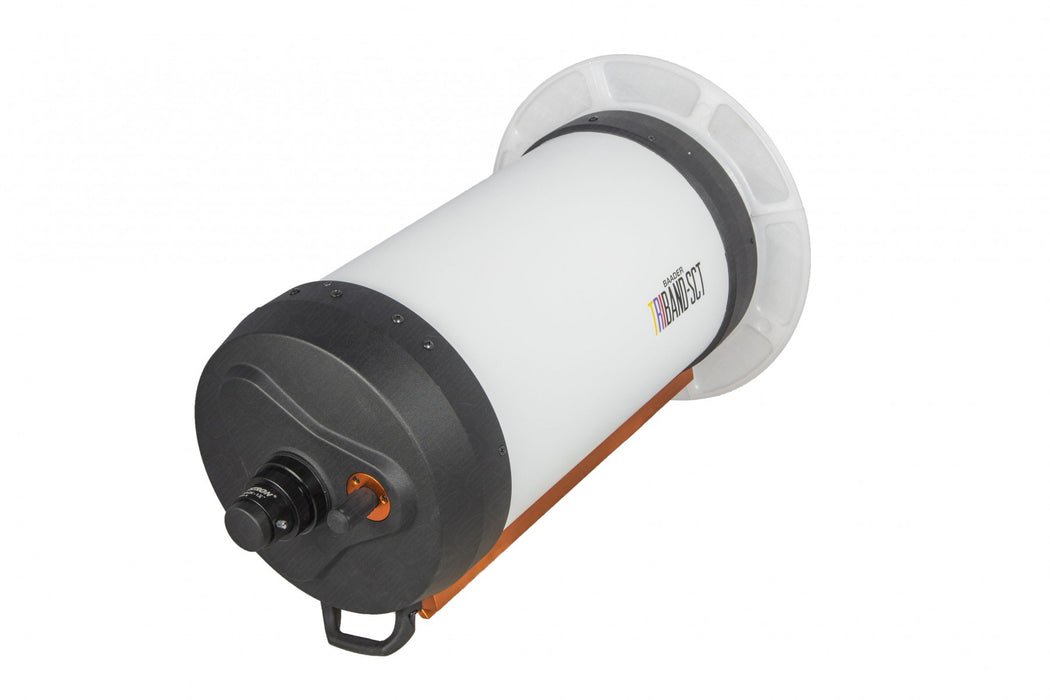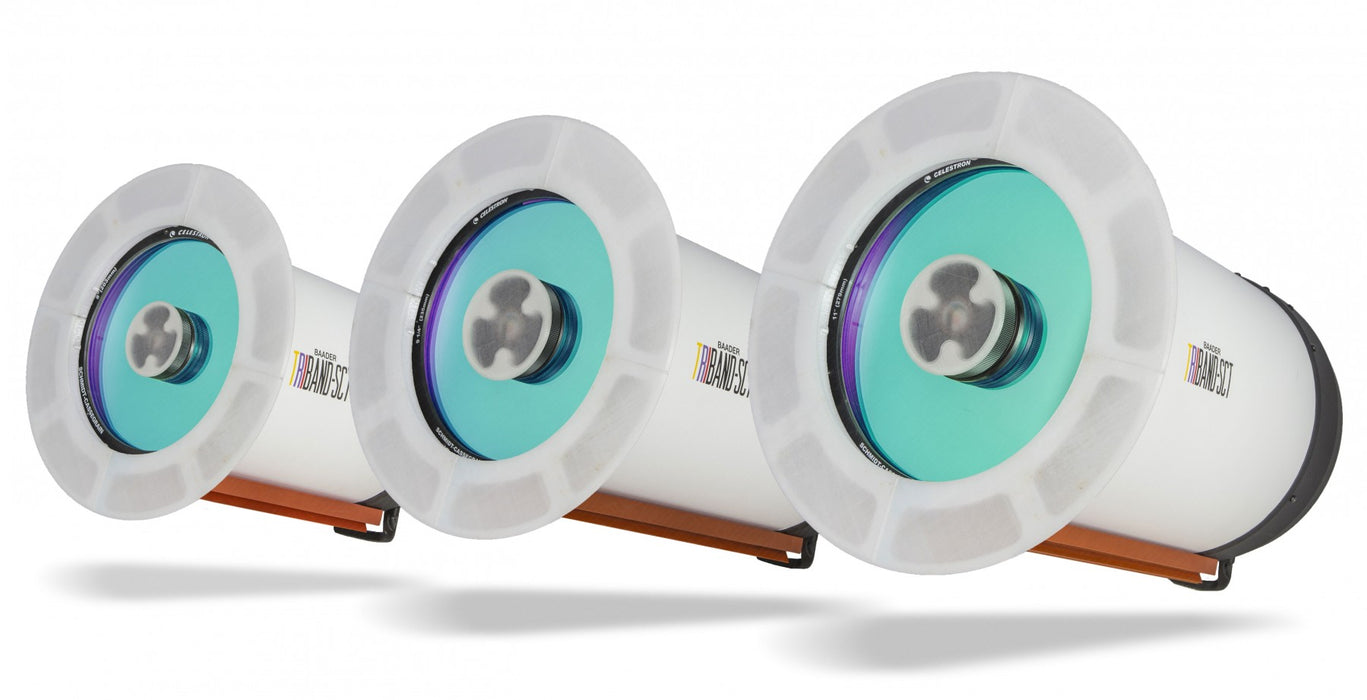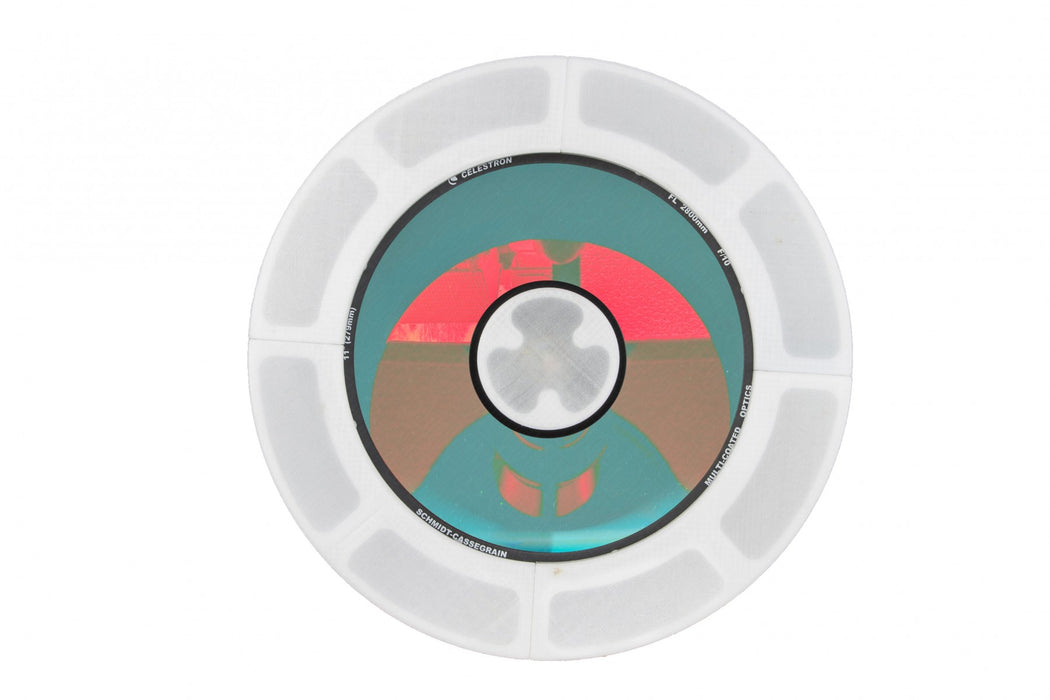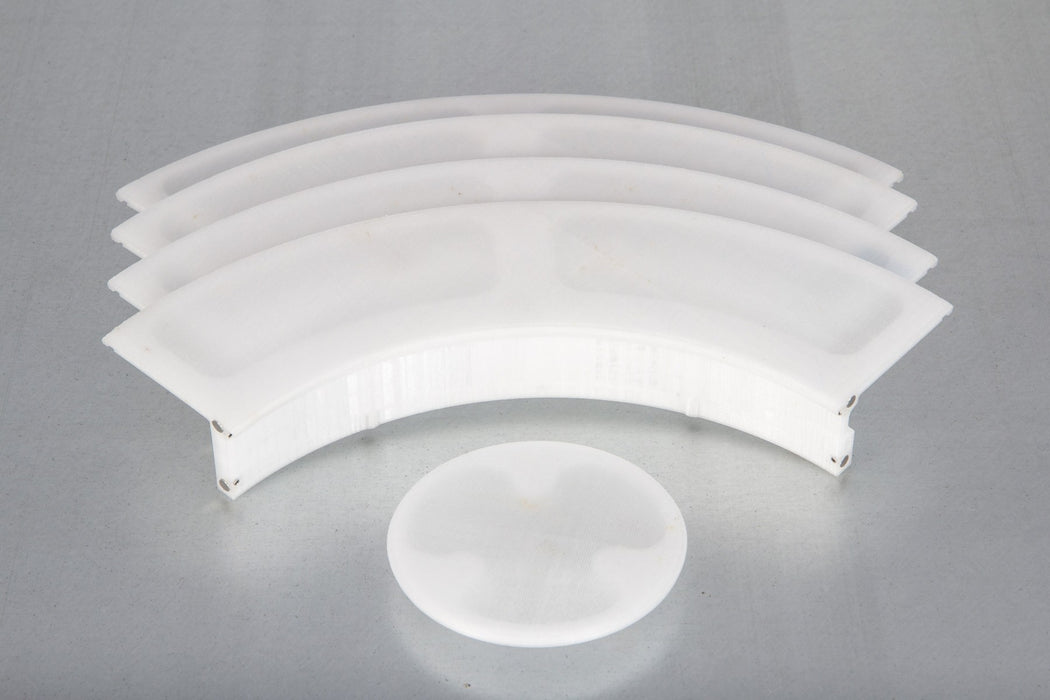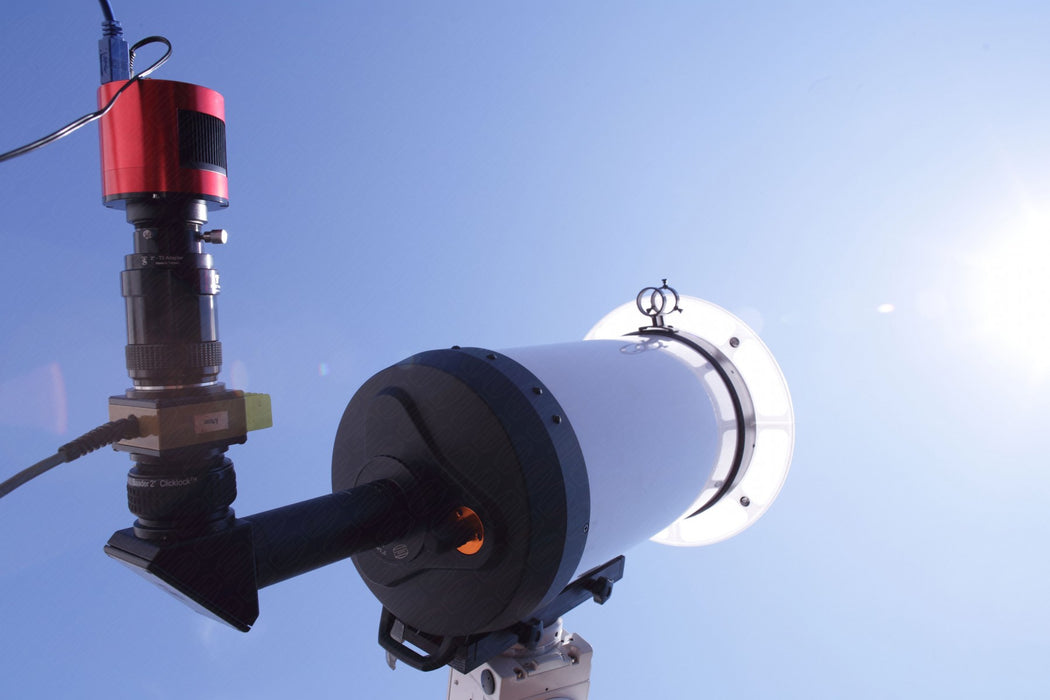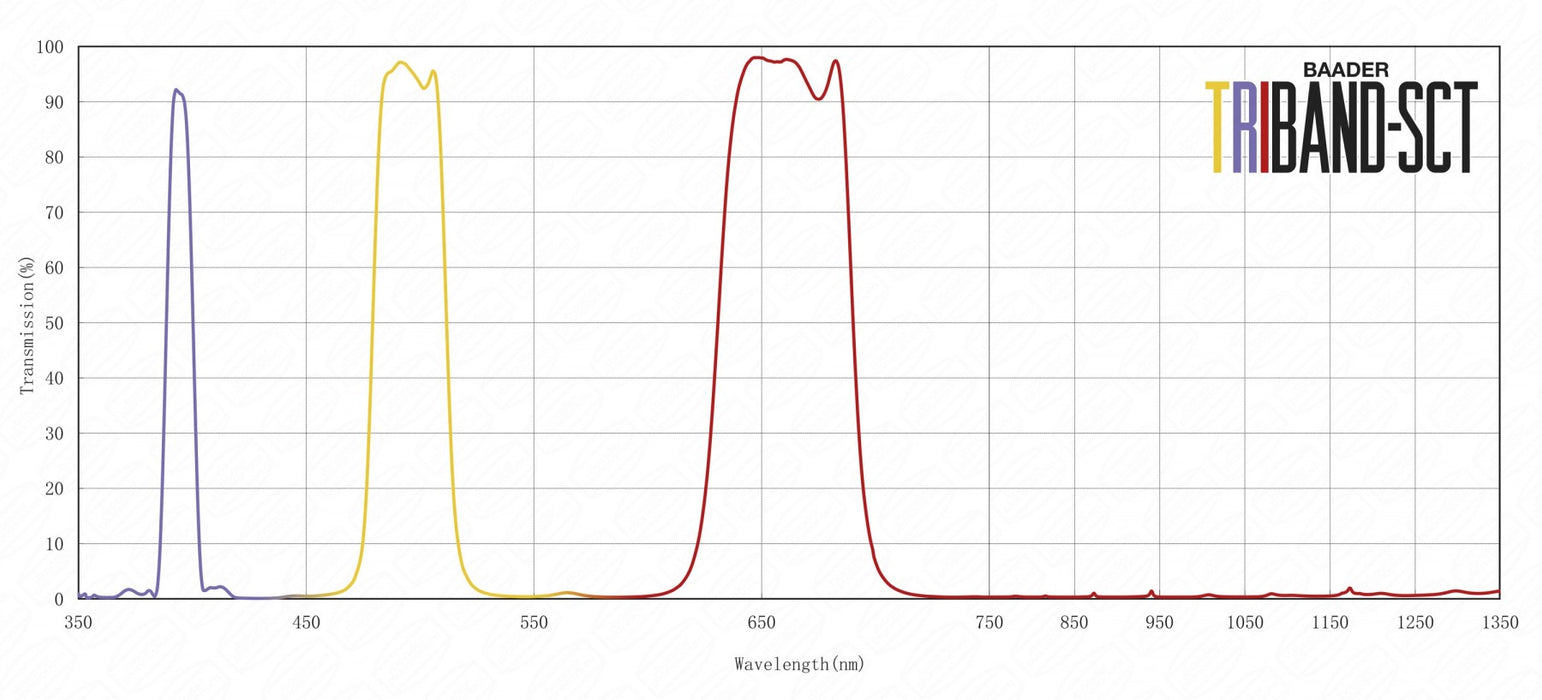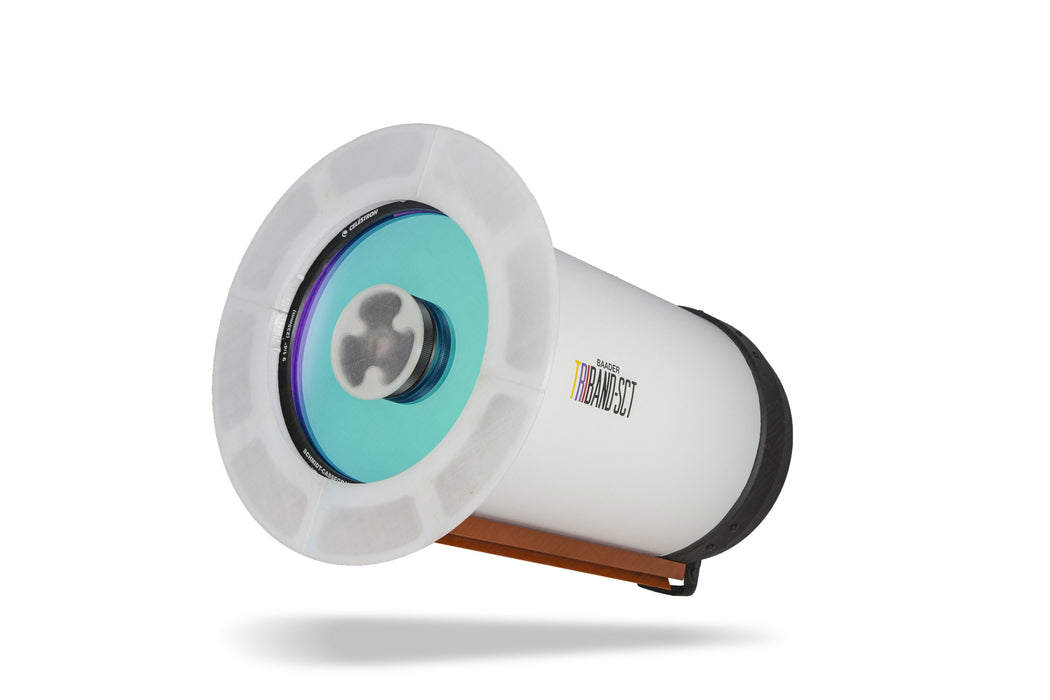Description
- Triband-SCT's are available in apertures of 8", 9¼" and 11".
- Triband-ERF-coated Schmidt corrector plate replaces an additional ERF energy rejection filter and makes high-resolution observations of the sun possible
- The Triband-ERF Schmidt corrector plate has got transmission windows between 380 and 400 nm, 480 and 515nm as well as 630 and 680 nm. The transmission windows are designed for Calcium-K, Continuum (incl H-beta and O III), H-alpha and S II.
- For observing the sun in white light, H-alpha or CaK or for Narrowband-Deep-Sky-applications, further filters are required.
Size matters – even for solar observing!
There are many small, nice telescopes available which are great for a quick look at the sun in H-alpha or CaK, but who wants to observe always only with a "finderscope"? To see faint details, you need aperture and focal length. The groundbreaking Baader Triband-SCTs have got the energy rejection filter (ERF) – which is necessary for the SolarSpectrum CaK and H-alpha filters – already integrated into the Schmidt corrector plate. Especially in IR, the Triband Schmidt corrector is blocked down to 1450nm, so that the telescope will not heat up. So, you do not need an additional large and precisely polished ERF, and you can use the full optical quality of the Schmidt corrector. Additional rear-ventilated heat shields in front of tube and secondary mirror also keep the tube from heating up by the sun's radiation. This way, you can use the full resolution which is available at your location. With videography it is possible to achieve extremely high-resolution detail images of the sun. And you can do this at three wavelengths – not only in H-alpha!
The system is also great for visual observations – the sun will impress you more than ever in those moments when the seeing is good. Please note that a Triband SCT is no grab-and-go-telescope: Smaller telescope with less magnification will show nice images even at poorer seeing conditions, but a high-end telescope which pushes everything to its limits also requires a proper location. Make sure that your surroundings don't cause bad local seeing – only then you can take the telescope to its limits! The Triband-SCTs are based on Celestron's Schmidt-Cassegrains, a well-tried and reliable no-frills telescope system.
Unlike pure H-alpha-telescopes, you can use the Triband-SCT even at night: The coating is permeable for CaK, H-Beta,O-III, H-alpha and S-II, so that you can use the telescope fully for narrowband- or Ultra UHC-photography – be it with the original f/10, at night with a reducer at f/7 or even with a Hyperstar-system at f/2. You can even use UV-filters (Baader U-Venus-filter) or IR-pass-filters and achieve a surprisingly good contrast. The SC optical system suffers much less from chromatic aberration over a much broader spectral range than the best apochromatic lens telescopes. This makes the Baader-Triband-Schmidt-Cassegrains the most versatile CaK and H-alpha-telescopes on the market.
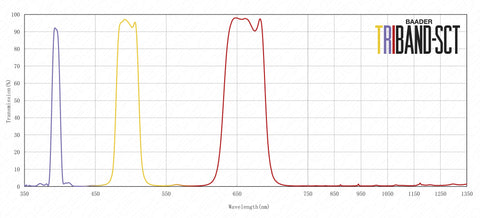
Triband SCT – Multi-purpose telescopes for professional applications
The Triband-SCs with Triband-ERF-coated Schmidt-corrector were designed on the base of the time-tested Celestron Schmidt-Cassegrain (SC) telescopes. They are the perfect telescopes for both high-resolution H-alpha solar observations and narrowband deep-sky photography.
Size matters – even for solar observing!
The Triband-coating is an Energy Rejection Filter for observing the sun, which does not interfere with narrowband deep-sky observations. Heat shields avoid heating ob of the telescope.
It is a common misconception that small telescopes are sufficient for observing the sun as high magnifications can rarely be used at daytime
The nice little H-alpha and CaK telescopes which are quite common nowadays are great for a quick look at the sun and to see the complete solar disk; but if you want to see fine details, you need aperture and focal length to make use of those moments when the seeing is perfect.
The groundbreaking Baader Triband-SCTs have got an Energy Rejection Filter (ERF) – which is necessary for the SolarSpectrum CaK and H-alpha filters – already integrated into the Schmidt corrector plate. You don't have to pay the additional costs for an Energy Rejection Filter (ERF), which would be "astronomical" for telescopes between 8 and 11 inch. With its Triband-coating, the telescope is still perfectly fitted for narrowband deep-sky-photography, although it was made for solar observing!

The Triband-coating is an Energy Rejection Filter for observing the sun, whihc does not interfere with narrowband deep-sky observations. Heat shields avoid heating of of the telescope.
The special Triband-ERF Schmidt corrector plate of the Triband-SCT has got transmission windows in the following parts of the spectrum: 380 to 400 nm, 480 to 515 nm and 630 to 680 nm.
Especially in IR, the Triband Schmidt corrector is blocked down to 1450nm, so that the telescope will not heat up. So, you do not need an additional large and precisely polished ERF, and you can use the full optical quality of the Schmidt corrector.
Additional rear-ventilated heat shields in front of tube and secondary mirror also keep the tube from heating up by the sun's radiation. This way, you can use the full resolution which is available at your location. With videography it is possible to achieve extremely high-resolution detail images of the sun. And you can do this at three wavelengths – not only in H-alpha! You can observe the sun in H-alpha as well as in CaK with a SolarSpectrum Filter, or in in continuum (white light) with a Herschel wedge or an ASTF filter.
The system is also great for visual observations – the sun will impress you more than ever in those moments when the seeing is good.
TriBand-frontfilter for narrowband observations
With a Triband-SCT, you get a Schmidt-Cassegrain optical tube assembly with a Triband-ERF-coated Schmidt corrector plate and rear ventilated heat shields for tube and secondary mirror (with Neodymium-magnetic holders). The transmission windows are designed for Calcium-K, Continuum (incl H-beta and O III), H-alpha, S II and let you use additional narrowband filters.
For the following uses, you need further equipment:
-
H-alpha: Solar Spectrum H-alpha filter, TZ-3 telecentric system and telecompressor TK0.4 or TK0.7. An additional D-ERF filter is not required.
-
CaK: Solar Spectrum CaK-filter, Calcium CaK filter plus additional front filter for observing the sun in CaK
-
White light: Safety Cool-Ceramic Herschel prism plus optional narrowband filters
-
Deep-Sky (not for solar observations!): Deep-sky filters according to your field of interest (RGB / H-beta / O-III / H-alpha / S-II)
Observing the sun in H-alpha
SolarSpectrum-Filter for H-alpha or CaK can be connected directly
The Triband-SC were developed for the SolarSpectrum H-alpha filters. The Energy Rejection Filter which is integrated into the Schmidt corrector plate eliminates the need for an additional D-ERF. The SolarSpectrum filters require the 2" Research Grade TZ-3 Telecentric System (3x focal length) (#2459257) , to perform at its best at f/30; with the Research Grade H-alpha 0.4x Telecompressor 2" for Solar Spectrum (#2459260) with 16mm corrected field of view, you almost regain the original focal length of the telescope and can work both visually and photographically at lower magnifications.

SolarSpectrum-Filter for H-alpha or CaK can be connected directly
Observing the sun in CaK
In addition to the transmission window between 630 and 680 nm for H-alpha observation, the Energy Rejection Filter has a second window between 380 and 400 nm, in the dark blue/UV. It is made for using SolarSpectrum CaK filters without an additional Energy Rejection Filter.
In addition, the Baader K-Line Filter 1¼" (double stacked) (#2458355) filter can be used, but only behind another filter such as a Baader Safety CoolCeramic Herschel Prism 2" Photographic (#2956510P) or AstroSolar photo film ND 3.8 (also available as BDSF: OD 3.8 Baader Digital Solar Filter 200mm (#2459376) in matching mount).
Observing the sun in continuum (white light)
Use a Herschel Wedge or an ASTF front filter to see the sun in white light with large apertures and high resolution.
Solar observation in white light can be done with a Baader Safety CoolCeramic Herschel Prism 2" Photographic (#2956510P) or a temperature-compensating ASTF front filter made of astrosolar film. The sun appears slightly light green. For increased contrast, we recommend a red filter like H-alpha 2" Bandpass filter (20nm) (#2961853) to reduce the influence of seeing, or the O-III 2" Super-G Filter (9nm) - CMOS optimized (#2961551) .
A note about solar observing
Please note that a Triband SCT is no grab-and-go-telescope: Smaller telescope with less magnification will show nice images even at poorer seeing conditions, but a high-end telescope which pushes everything to its limits also requires a proper location. Make sure that your surroundings don't cause bad local seeing – only then you can take the telescope to its limits!

Use a Herschel Wedge or an ASTF front filter to see the sun in white light with large apertures and high resolution.
Deep-Sky narrowband observation and narrowband photography
The Triband-SCTs are based on Celestron's Schmidt-Cassegrains, a well-tried and reliable no-frills telescope system. That's why they are also compatible with a multitude of accessories which was developed for regular Schmidt-Cassegrains – starting with filter drawers like the UFC or focusers like the Baader Diamond SteelTrack with optional motor focuser or the Celestron Focusmotor#821160 up to reducers.
Unlike pure H-alpha-telescopes, you can use the Triband-SCT even at night: The coating is permeable for CaK, H-Beta, O-III, H-alpha and S-II, so that you can use the telescope fully for narrowband- or Ultra UHC-photography – be it with the original f/10, at night with a reducer or even with a Hyperstar-system at f/2. You can even use UV-filters ( Baader U-Venus-Filter 2" (350nm) (#2458291) (Baader U-Venus-Filter) or IR-Pass-Filters ( Baader IR-Pass Filter 1¼" (685 nm) (#2458385) and achieve a surprisingly good contrast. The SC optical system suffers much less from chromatic aberration over a much broader spectral range than the best apochromatic lens telescopes. This makes the Baader-Triband-Schmidt-Cassegrains the most versatile CaK and H-alpha-telescopes on the market.
Specifications
8" SCT
| SIZE GENERAL |
8" SCT |
| MANUFACTURER |
Baader Planetarium |
| SKU (#) |
2301002 |
| EAN CODE |
4047825038784 |
| NET WEIGHT (KG) |
6.25 |
| FILTER MOUNTED? |
Yes |
9.25" SCT
| SIZE GENERAL |
9.25" SCT |
| MANUFACTURER |
Baader Planetarium |
| SKU (#) |
2301003 |
| EAN CODE |
4047825038791 |
| NET WEIGHT (KG) |
10.00 |
| FILTER MOUNTED? |
Yes |
11" SCT
| SIZE GENERAL |
11" SCT |
| MANUFACTURER |
Baader Planetarium |
| SKU (#) |
2301004 |
| EAN CODE |
4047825038807 |
| NET WEIGHT (KG) |
13.10 |
| FILTER MOUNTED? |
Yes |
Downloads
Baader Triband-SCT: Manual and Application Tips
Related Articles
FIRST CLASS H-ALPHA SOLAR FILTERS BY SOLARSPECTRUM
SOLAR OBSERVATION AND H-ALPHA-FILTERS FOR SCHMIDT CASSEGRAINS
FOCUS ON THE SUN: CAN THE BAADER SC-TRIBAND REPLACE A LARGE REFRACTOR?
TRIBAND 8" TESTING AT THE ROS ASTRONOMICAL MEETING (RENCONTRE DES OBSERVATEURS SOLAIRES) IN SERBANNES, FRANCE, JUNE 23 - 24, 2018
